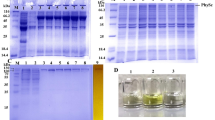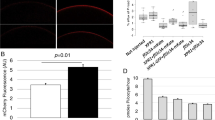Abstract
The Na+/H+ exchanger is a ubiquitous protein that transports Na+ and H+ in opposite directions across cell membranes. In fission yeast, the Na+/H+ exchanger sod2 plays a major role in the removal of excess detrimental intracellular sodium. The effect of mutagenesis of conserved polar amino acids of sod2 was examined by expressing 10 different mutant forms of sod2 in sod2 deficient S. pombe and characterizing salt tolerance. Asp145, 266, 267, and Glu173 were critical for proper function of sod2. Asp241 had an intermediate effect on sod2 function while mutation of Asp178 did not impair sod2 function. Simultaneous mutation of the Asp266, 267 pair impaired sod2 function. Mutation of each individual residue demonstrated that both were critical for sod2 function. Conservative mutations (Asp to Glu) of Asp266 and 267 failed to restore sod2 function. The results suggest that acidic residues associated with transmembrane segments are important in function, possibly being important in binding and coordinating cations. (Mol Cell Biochem 268: 83–92, 2005)
Similar content being viewed by others
References
Serrano R, Mulet, JM, Rios G, Marquez, JA, de Larrinoa, IF, Leube MP, Mendizabal I, Pascual-Ahuir A, Proft M, Ros R, Montesinos C: A glimpse of the mechanisms of ion homeostasis during salt stress. J Expl Botany 50: 1023–1036, 1999
Blumwald, E: Sodium transport and salt tolerance in plants. Curr Opin Cell Biol 12: 431–434, 2000
Jia Z-P, McCullough N, Martel R, Hemmingsen S, Young PG: Gene amplification at a locus encoding a putative Na+/H+ antiporter confers sodium and lithium tolerance in fission yeast. EMBO J 11: 1631–1640, 1992
Dibrov P, Smith JJ, Young P, Fliegel L: Identification and localization of the sod2 gene product in fission yeast. FEBS Lett 405: 119–124, 1997
Dibrov P, Young PG, Fliegel L: Functional analysis of amino acid residues essential for activity in the Na+/H+ exchanger of fission yeast. Biochemistry 36: 8282–8288, 1998
Dibrov P, Fliegel L: Comparative molecular analysis of Na+/H+ exchangers: A unified model for Na+/H+ antiport? FEBS Lett 424: 1–5, 1998
Wiebe, CA, DiBattista, ER, Fliegel, L: Functional role of amino acid residues in Na+/H+ exchangers. Biochem J 357: 1–10, 2001
Padan E, Venturi M, Gerchman Y, Dover N: Na+/H+ antiporters. Biochim Biophys Acta 1505: 144–157, 2001
Murtazina R, Booth BJ, Bullis BL, Singh DN, Fliegel L: Functional analysis of polar amino acid residues in membrane associated regions of the NHE1 isoform of the Na+/H+ exchanger. Eur J Biochem 268: 1–13, 2001
Slepkov ER, Chow S, Lemieux MJ, Fliegel L: Proline residues in transmembrane segment IV are critical for activity, expression and targeting of the Na+/H+ exchanger isoform 1. Biochem J 379, 31–38, 2004
Moreno S, Klar A, Nurse P: Molecular genetic analysis of fission yeast Schizosaccharomyces pombe. Methods Enzymol 194: 795–823, 1991
Toone WM, Kuge S, Samuels M, Morgan BA, Toda T, Jones N: Regulation of the fission yeast transcription factor Pap1 by oxidative stress: Requirement for the nuclear export factor Crm1 (Exportin) and the stress-activated MAP kinase Sty1/Spc1. Genes Dev 12: 1453–1463, 1998
Claros M, von Heijne G: TopPredII: An improved software for membrane protein structure predictions. Comput Applic Biosci 10: 685–686, 1994
Nass R, Rao R: Novel localization of a Na+/H+ exchanger in a late endosomal compartment of yeast. J Biol Chem 273: 21054–21060, 1998.
Nakamura T, Komano Y, Unemoto T: Three aspartic residues in membrane-spanning regions of Na+/H+ antiporter from Vibrio alginolyticus play a role in the activity of the carrier. Biochim Biophys Acta 1230: 170–176, 1995
Noumi T, Inoue H, Sakurai T, Tsuchiya T, Kanazawa H: Identification and characterization of functional residues in a Na+/H+ antiporter (NhaA) from Escherichia coli by random mutagenesis. J Biochem 121: 661–670, 1997
Wakabayashi S, Pang T, Su X Shigekawa M: A novel topology model of the human Na+/H+ exchanger isoform 1. J Biol Chem 275: 7942–7949, 2000
Wiebe CA, Rieder C, Young PG, Dibrov P, Fliegel, L: Functional analysis of amino acids of the Na+/H+ exchanger that are important for proton translocation. Mol Cell Biochem 254: 117–124, 2003
Watanabe Y, Shimono Y, Tsuji H, Tamai Y: Role of the glutamic and aspartic residues in Na+-ATPase function in the ZrENA1 gene of Zygosaccharomyces rouxii. FEMS Microbiol Lett 209: 39–43, 2002
Inoue H, Noumi T, Tsuchiya T, Kanazawa H: Essential aspartic acid residues, Asp-133, Asp-163 and Asp-164, in the transmembrane helices of a Na+/H+ antiporter (NhaA) from Escherichia coli. FEBS Lett 363: 264–268, 1995
Lee JI, Varela MF, Wilson TH: Physiological evidence for an interaction between Glu-325 and His-322 in the lactose carrier of Escherichia coli Biochimica et Biophysica Acta 1278: 111–118, 1996
Pourcher T, Deckert M, Bassilana M, Leblanc G: Melibiose permease of Escherichia coli: Mutation of aspartic acid 55 in putative helix II abolishes activation of sugar binding by Na+ ions. Biochem Biophys Res Commun 178: 1176–1181, 1991
Mogi T, Stern LJ, Marti T, Chao, BH Khorana HG: Aspartic acid substitutions affect proton translocation by bacteriorhodopsin. Proc. Natl. Acad. Sci. USA 85: 4148–4152, 1988
Otto H, Marti T, Holz M, Mogi T, Lindau M, Khorana HG, Heyn MP: Aspartic acid-96 is the internal proton donor in the reprotonation of the Schiff base of bacteriorhodopsin. Proc Natl Acad Sci USA 86: 9228–9232, 1989
Nicoll DA, Hryshko LV, Matsuoka S, Frank JS, Philipson KD: Mutation of amino acid residues in the putative transmembrane segments of the cardiac Na+-Ca2+ exchanger. J Biol Chem 271: 13385–13391, 1996
Clarke DM, Loo TW, Maclennan DH: Functional consequences of alterations to polar amino acids located in the transmembrane domain of the Ca2+-ATPase of sarcoplasmic reticulum. J Biol Chem 265: 6262–6267, 1990
Orlowski J, Shull G: (1996). Characteristics of the plasma membrane Na+/H+ exchanger gene family. In: L. Fliegel (ed). The Na+/H+ Exchanger, R.G. Landes Company, 1996, pp 123–148
Frohlich O: The NHE family of Na+/H+ exchangers; Its known and putative members and what can be learned by comparing them with each other. In: L. Fliegel (ed). The Na+/H+ Exchanger. R.G. Landes Company, 1996, pp 295–307
Watanabe Y, Miwa, S, Tamai Y: Characterization of Na+/H+ -antiporter gene closely related to the salt-tolerance of yeast Zygosacchromyces rouxii. Yeast 11: 829–838, 1995
Kamauchi S, Mitsui K, Ujike S, Haga M, Nakamura N, Inoue H, Sakajo S, Ueda M, Tanaka A, Kanazawa H: Structurally and functionally conserved domains in the diverse hydrophilic carboxy-terminal halves of various yeast and fungal Na+/H+ antiporters (nha1p). J Biochem (Tokyo) 131: 821–831, 2002
Prior C, Potier S, Souciet J-L, Sychrova H: Characterization of the NHA1 gene encoding a Na+/H+ -antiporter of the yeast Saccharomyces cerevisiae. FEBS Lett 387: 89–93, 1996
Nass R, Cunningham KW, Rao R: Intracellular sequestration of sodium by a novel Na+/H+ exchanger in yeast is enhanced by mutations in the plasma membrane H+-ATPase. Insights into mechanisms of sodium tolerance. J Biol Chem 272: 26145–26152, 1997
Galili L, Rothman A, Kozachkov L, Rimon A, Padan E: Trans membrane domain IV is involved in ion transport activity and pH regulation of the NhaA-Na+/H+ antiporter of Escherichia coli. Biochemistry 41: 609–617, 2002
Kuroda T, Shimamoto T, Inaba K, Tsuda M, Tsuchiya T: Properties and sequence of the NhaA Na+/H+ antiporter of Vibrio parahaemolyticus. J Biochem 116: 1030–1038, 1994
Nakamura T, Komano Y, Itaya E, Tsukamoto K, Tsuchiya T, Unemotoe T: Cloning and sequencing of a Na+/H+ antiporter gene from the marine bacterium Vibrio alginolyticus. Biochim Biophys Acta 1190: 465–468, 1994
Sardet C, Franchi A, Pouysségur J: Molecular cloning, primary structure, and expression of the human growth factor-activatable Na+/H+ antiporter. Cell 56: 271–280, 1989
Wang Z, Orlowski J, Shull GE: Primary structure and functional expression of a novel gastrointestinal isoform of the rat Na+/H+ exchanger. J Biol Chem 268: 11925–11928, 1993
Orlowski J, Kandasamy RA, Shull GE: Molecular cloning of putative members of the Na+/H+ exchanger gene family. J Biol Chem 267: 9331–9339, 1992
Author information
Authors and Affiliations
Corresponding author
Rights and permissions
About this article
Cite this article
Fliegel, L. Identification of conserved polar residues important for salt tolerance by the Na+/H+ exchanger of Schizosaccharomyces pombe. Mol Cell Biochem 268, 83–92 (2005). https://doi.org/10.1007/s11010-005-3696-6
Received:
Accepted:
Issue Date:
DOI: https://doi.org/10.1007/s11010-005-3696-6




